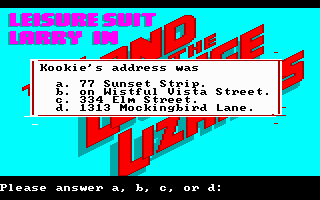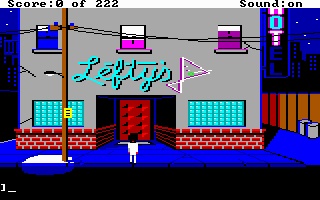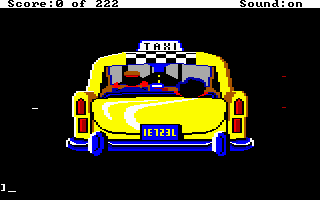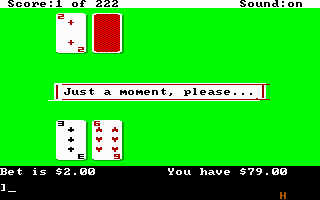Leisure Suit Larry in the Lands of the Lounge Lizards
Released: 1987
Published by: Sierra On-Line, Inc.
Developed by: Sierra On-Line, Inc.
Credits: Al Lowe, Chuck Benton, Mark Crowe, Ken Williams
System Requirements
| System Requirements | 8088 or 8086 and compatibles. 256K RAM required. DOS 2.11 or later. Hercules monochrome/CGA/Composite CGA/EGA/VGA graphics supported. Audio support for PC speaker or Tandy only. Supports a joystick. *An unofficial "experimental" patch allows 3-voice music to be played from an MPU-401 interface* |
|---|---|
| Original Media | Two 5.25" 360 KB (DD) disks (original version 1.00) |
| Installed Size | 540 KB of hard disk space. |
Introduction
Meet Larry. He's just turned 40, and he's still single. If you can get past the glow of his Grecian formula, you can see his hairline beginning to make a hasty retreat from his forehead. Larry's leisure suit is of the highest quality (100% manmade material, permanent press too!). He wears at least 11 gold chains and his freshly-capped teeth could blind you in a bright light.
Down at the singles bar he tells the chicks, "Sure, I'm single... I got in a fight with my ol' lady and she threw me out." He doesn't tell them the "ol' lady" was his mom, or that he was 38 at the time.
Yeah, Larry's a jerk. He's the original blind date nightmare. The kind of guy you wouldn't want your daughter to date, let alone meet. But he's also the unlikely "hero" of this new 3-D Animated Graphic Adventure Game from the makers of the King's Quest series.
3-D equals dancing, drinking and dames! Become the loveable nerd Larry for one fabulous night. You'll dance. You'll drink. You'll gamble. And, if you play your cards right, you might even meet the girl (or girls) of your dreams.
Leisure Suit Larry is a humorous, harmless
endeavor for adults. The object of the game is to help Larry overcome his jerkisms, and lose his "you-know-what". It's a silly, risque romp through the singles scene and a challenging adventure game that will test your street smarts and suave sophistication.
So, slip into your leisure suit and venture out into "the land of the lounge lizards." We guarantee it'll be a night you will never forget.
A new 3-D animated adventure game featuring:
- Animated characters that come alive; they walk, talk, lounge, and even ignore your best pick up lines - just like in real life.
- Incredible three-dimensional graphics; move your animated Larry character in front of speeding cabs, into hot tubs, and smoothly around the disco floor - other onscreen characters do the same and more.
- Communicate using full sentence input and optional joystick. The game understands over 900 words (including some of your four-letter favorites).
From where can it be run?
From the original floppy disks only.
Game Audio/Video
TBC...
Copy Protection
All versions of Leisure Suit Larry (in fact all AGI2 titles from Sierra) were supplied with the first disk being a "Key" disk - an early copy protection method. Key disks used a track on the disk (usually track 0) that had a checksum error or used a non-standard sector size on that track. The main executable file (SIERRA.COM) would make a check for this non-standard track, and if found would read a decryption key from it and decrypt the real executable file, which is "AGI". This protection was called "SuperLok 3.2".
LSL also has an interesting secondary layer of copy protection, which asks you 5 questions to confirm your age. These are comical in nature, so it's sometimes possible to get them wrong, or fail to recognise the correct answer if you're not from the USA. You are allowed to get one question wrong and still continue, but after 2 incorrect choices you are told you're too young to play, and are returned to the DOS prompt.
How to Setup
The game does not come with a setup/install program like later Sierra titles. All versions check the BIOS for an ID string that matches an IBM PCjr or Tandy 1000 and will initialise those systems' 3-voice PCG sound data and also load those graphics drivers. However, there are some command-line options to force the graphics mode. Simple run LL.COM with:
| Argument | Meaning |
|---|---|
| -c | Forces CGA Composite colour mode (320 x 200 in 16 colours) |
| -r | Forces CGA RGB colour mode (320 x 200 in 4 colours) |
| -h | Forces Hercules (HGC) mono mode for TTL monitors |
| -e | Forces EGA mode (320 x 200 in 16 colours) |
| -v | Forces MCGA/VGA mode (320 x 200 in 16 colours) |
| -t | Forces Tandy 1000 graphics and sound (320 x 200 in 4 colours) |
| -p | Forces "PC" mode (assumed to tell it you're running a PC not a PCjr or Tandy) |
| -s | An unknown flag - not sure what this does |
My version of this game has AGI interpreter version 2.917 (the most up-to-date interpreter released for this game), and by default it runs in EGA graphics mode. Running with the -c option worked well. -h wasn't tested as it requires a TTL (digital signal) monitor.
Problems
Issue: Corrupted graphics or garbled text, unreadable.
Cause: This can occur if running the game with a modern graphics card under Windows 95, 98 or ME.
Resolution:
Either run it on period-correct hardware (including the graphics card) or run it in DOSBox. There are also several third-party AGI interpreters that fix many bugs when running on more modern computers - try ScummVM or NAGI. There was another called Sarien but that has since merged with ScummVM.
To Quit the Game
Simply type the word "QUIT" and hit enter. Then either hit ENTER again to confirm or ESC to cancel.
Supporting Documents
Here are the original documents that came with the game:
And here are some aftermarket links:
Save Games
The location of save game files is entirely up to you! When you type the word "SAVE" (or press F5) you will be prompted for a directory where you wish the save game file to be stored. By default this will be the same directory in which the executable file was run.
Once you've chosen the location you are shown 12 'slots' in which save games can be stored. Any slots that have a save game already stored will display their description. Once the slot has been chosen, you are prompted to give a description for the save game. Once completed, the save game will be stored in a file called lllllsg.x where x is the slot number from 1 to 12.
This is actually a great way of storing save games, as you are not limited to 12 slots - if you need more you can create a directory anywhere and use that to store a further 12 save games.
To restore a saved game, type the word "RESTORE" (or press F7) and you will be prompted for the location where your save games are stored. By default this will be the same directory in which the executable game file was run. After choosing a drive/directory, the list of save games that exist in that directory are shown. Move the arrow keys to the one you wish to restore, and hit <Enter>.
Versions of the game known to exist
| Version | Date | Comments |
|---|---|---|
| 1.00 | 1st June 1987 | 5.25" 360 KB version. Comes with AGI2 intepreter v2.917. This version of the game only supports CGA, Hercules, Tandy/PCjr and EGA graphics. |











